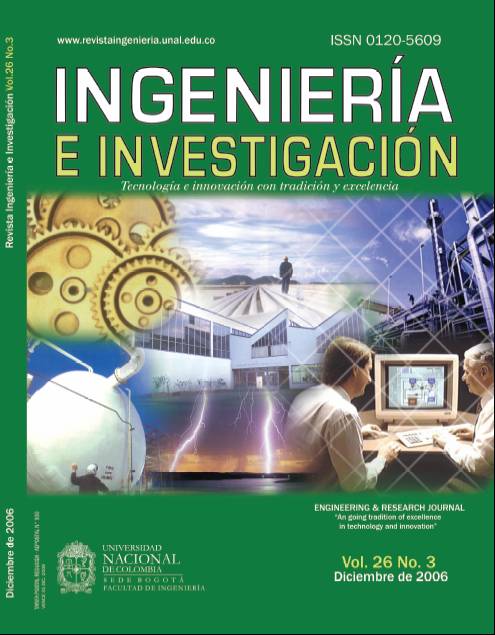A thermodynamic approach to choosing pervaporatives membranes
Selección de membranas pervaporativas mediante criterios termodinámicos
DOI:
https://doi.org/10.15446/ing.investig.v26n3.14747Keywords:
membrane, polymer, solvent, pervaporation, thermodynamics, interaction, solubility (en)membrana, polímero, solvente, pervaporación, termodinámica, interacción, solubilidad (es)
Downloads
This work describes separating a mixture of several components obtained as a product of methyl polymethyl methacrylate (PMMA) thermo-degradation. It was aimed at purifying methyl methacrylate monomer (MMA) obtained by 95% mass thermal degradation to reach 99.5% maximum pervaporation concentration. This work studied the theory of pervaporation and applying the main thermodynamic criteria for choosing suitable polymer membranes for separating the MMA/PRP/ISB mixture. Such thermodynamic criteria were based on monomer interaction with and solubility on the membrane. The advantage of using this separation technique lies mainly in the fact that this method has low energy consumption compared to other processes, such as distillation or crystallisation.
Este trabajo describe la separación de una mezcla de varios componentes obtenidos como productos del proceso de termo-degradación del polimetacrilato de metilo (PMMA). Se purificó el monómero de metacrilato de metilo, obtenido por degradación térmica 95% en masa, mediante el proceso de pervaporación hasta obtener una concentración máxima de 99.5%. El objetivo de este trabajo consistió en realizar una revisión conceptual sobre pervaporación y en la aplicación de los principales criterios termodinámicos para la selección de membranas poliméricas para la separación de la mezcla MMA/PRP/ISB. Estos criterios termodinámicos se basan en parámetros de interacción y solubilidad de los monómeros sobre la membrana. La ventaja principal de la utilización de esta técnica de separación reside en el bajo consumo de energía comparado con otros procedimientos, tales como la destilación o la cristalización.
References
Mulder, M.V.H., Basic Principles of Memnrane Technology, 2nd Edition, Kluwer Academic Publishers, 1996, pp. 584.
Huang, R.Y. and Lin, V.J.C., Separation of liquid mixtures by using polymer membranes. I. Permeation of binary organic liquid mixtures through polyethylene., J.Appl. Polym. Sci, 12, 1968, pp. 2615-2631. DOI: https://doi.org/10.1002/app.1968.070121204
Fels, M. and Huang., R.Y.M., Theoretical interpretation of the effect of mixture composition on separation of liquids in polymers., J. Macromol. Sci. Phys., B5, 1, 1971, pp. 89-110. DOI: https://doi.org/10.1080/00222347108212522
Heintz, A. and Stephan, W.J., A generalized solution-diffusion model of the pervaporation process through composite membranes Part I. Prediction of mixture solubilities in the dense active layer using the UNIQUAC model, J. Membrane Sci., 89, 1994, pp. 143-151. DOI: https://doi.org/10.1016/0376-7388(93)E0222-6
Greenlaw, FW., Shelden, R.A. and Thompson, E.V., Dependence of diffusive permeation rates on upstream and downstream pressures: Il. Two component permeant., J. Membrane Sci., 2, 1977, pp. 333-348. DOI: https://doi.org/10.1016/S0376-7388(00)83261-5
Long, R.B., Liquid Permeation through Plastic Films., Ind. Eng. Chem. Fundam.,4, 1965, pp. 445 - 451. DOI: https://doi.org/10.1021/i160016a015
Mulder, M.H.V. and Smolders, C.A, On the mechanism of separation of ethanol/water mixtures by pervaporation I. Calculations of concentration profiles, J. Membrane Sci., 17, 1994, pp. 289-307. DOI: https://doi.org/10.1016/S0376-7388(00)83220-2
Wei, Y. and Huang, R.Y.M., Selective sorption of latex membranes with ethanol-water mixtures., Sep. Sc. Technol., 29, 1994, pp. 301-314. DOI: https://doi.org/10.1080/01496399408002485
Matsura, T., Synthetic membranes and membranes processes., 467 pp, CRC Press Inc, Boca Raton, 1994.
Favre, E., Nguyen, Q.T, Schaetzel, P, Clement, R. and Neel, J., Sorption of organic solvents into dense silicon membranes, Part.I, Validity and limitations of Flory-Huggins and related theories., J. Chem. Soc. Faraday Trans., 89, 1993, pp. 4339-4346. DOI: https://doi.org/10.1039/FT9938904339
Favre, E., Shaetzel, P, Nguygen, Q.T., Clément, R. and Néel, J., Sorption, diffusion and vapor permeation of various penetrants through dense poly(dimethylsiloxane) membranes: a transport analysis., J. Membrane Sci., 92, 1994, pp. 169-184. DOI: https://doi.org/10.1016/0376-7388(94)00060-3
Barton, A.EM, Handbook of polymer-liquid interaction parameter and solubility parameters., Murdoch University, CRC Press, Australie, 1990, pp. 768.
Rodríguez, F, Cohen, C. and Archer, L., Principles of polymer systems., Taylor & Francis Books, 5th Edition, 2003, pp. 774. DOI: https://doi.org/10.1201/b12837
How to Cite
APA
ACM
ACS
ABNT
Chicago
Harvard
IEEE
MLA
Turabian
Vancouver
Download Citation
CrossRef Cited-by
1. Mahacine Amrani. (2008). Separating a water-propanol mixture using PDMS pervaporation membranes. Ingeniería e Investigación, 28(2), p.53. https://doi.org/10.15446/ing.investig.v28n2.14892.
Dimensions
PlumX
Article abstract page views
Downloads
License
Copyright (c) 2006 Mahacine Amrani

This work is licensed under a Creative Commons Attribution 4.0 International License.
The authors or holders of the copyright for each article hereby confer exclusive, limited and free authorization on the Universidad Nacional de Colombia's journal Ingeniería e Investigación concerning the aforementioned article which, once it has been evaluated and approved, will be submitted for publication, in line with the following items:
1. The version which has been corrected according to the evaluators' suggestions will be remitted and it will be made clear whether the aforementioned article is an unedited document regarding which the rights to be authorized are held and total responsibility will be assumed by the authors for the content of the work being submitted to Ingeniería e Investigación, the Universidad Nacional de Colombia and third-parties;
2. The authorization conferred on the journal will come into force from the date on which it is included in the respective volume and issue of Ingeniería e Investigación in the Open Journal Systems and on the journal's main page (https://revistas.unal.edu.co/index.php/ingeinv), as well as in different databases and indices in which the publication is indexed;
3. The authors authorize the Universidad Nacional de Colombia's journal Ingeniería e Investigación to publish the document in whatever required format (printed, digital, electronic or whatsoever known or yet to be discovered form) and authorize Ingeniería e Investigación to include the work in any indices and/or search engines deemed necessary for promoting its diffusion;
4. The authors accept that such authorization is given free of charge and they, therefore, waive any right to receive remuneration from the publication, distribution, public communication and any use whatsoever referred to in the terms of this authorization.



























